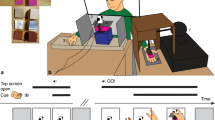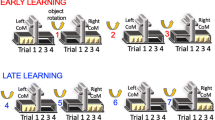Abstract
Language comprehension requires a simulation process that taps perception and action systems. How specific is this simulation? To address this question, participants listened to sentences referring to the lifting of light or heavy objects (e.g., pillow or chest, respectively). Then they lifted one of two boxes that were visually identical, but one was light and the other heavy. We focused on the kinematics of the initial lift (rather than reaching) because it is mostly shaped by proprioceptive features derived from weight that cannot be visually determined. Participants were slower when the weight suggested by the sentence and the weight of the box corresponded. This effect indicates that language can activate a simulation which is sensitive to intrinsic properties such as weight.




Similar content being viewed by others
Notes
Objects mass is an intrinsic object property that does not depend on the object spatial position, whereas object weight is the gravitational field effect on this mass. However, from here on, we will refer to mass as ‘weight’, following the literature mainstream.
Span: the distance between the tip of the thumb and the tip of the little finger, when the hand is fully extended.
References
Barsalou LW (2008a) Cognitive and neural contributions to understanding the conceptual system. Curr Dir Psychol Sci 17:91–95
Barsalou LW (2008b) Grounded cognition. Annu Rev Psychol 59:617–645
Bosbach S, Cole J, Prinz W, Knoblich G (2005) Inferring another’s expectation from action: the role of peripheral sensation. Nature 8:1295–1297
Boulanger V, Roy AC, Paulignan Y, Deprez V, Jeannerod M, Nazir TA (2006) Cross-talk between language processes and overt motor behavior in the first 200 msec of Processing. J Cogn Neurosci 18:1607–1615
Brenner E, Smeets JBJ (1996) Size illusion influences how we lift but not how we grasp an object. Exp Brain Res 111:473–476
Brouwer AM, Georgiou G, Glover S, Castiello U (2006) Adjusting reach to lift movements to sudden visible changes in target’s weight. Exp Brain Res 173:629–636
Buccino G, Riggio L, Melli G, Binkofsky F, Gallese V, Rizzolatti (2005) Listening to action relating sentences modulates the activity of the motor system: a combined TMS and behavioral study. Cogn Brain Res 24:355–363
Eastough D, Edwards M (2007) Movement kinematics in prehension are affected by grasping objects of different mass. Exp Brain Res 176:193–198
Fischer M, Zwaan RA (2008) Embodied language: a review of the role of the motor system in language comprehension. Q J Exp Psychol 61:825–850
Gallese V (2007) Before and below theory of mind: embodied simulation and the neural correlates of social cognition. Proc R Soc Biol Biol 362:659–669
Gallese V (2008) Mirror neurons and the social nature of language: the neural exploitation hypothesis. Soc Neurosci (in press)
Gallese V, Goldman A (1998) Mirror neurons and the simulation theory of mind reading. Trends Cogn Sci 2:493–501
Gentilucci M (2003a) Object motor representation and language. Exp Brain Res 153:260–265
Gentilucci M (2003b) Grasp observation influences speech production. Eur J NeuroSci 17:179–184
Gentilucci M, Gangitano M (1998) Influence of automatic word reading on motor control. Eur J NeuroSci 10:752–756
Gentilucci M, Chieffi S, Scarpa M, Castiello U (1992) Temporal coupling between transport and grasp components during prehension movements: effects of visual perturbation. Behav Brain Res 47:71–82
Gentilucci M, Benuzzi F, Bertolani L, Daprati E, Gangitano M (2000) Language and motor control. Exp Brain Res 133:468–490
Glenberg AM, Kaschak MP (2002) Grounding language in action. Psychon Bull Rev 9:558–565
Glover S (2004) Separate visual representations in the planning and control of action. Behav Brain Sci 27:3–78
Glover S, Dixon P (2002) Semantics affect the planning but not control of grasping. Exp Brain Res 146:383–387
Glover S, Rosenbaum DA, Graham J, Dixon P (2004) Grasping the meaning of words. Exp Brain Res 154:103–108
Goodale MA (1998) Visuomotor control: Where does vision end and action begin? Curr Biol 8:R489–R491
Hamilton A, Wolpert D, Frith U (2004) Your own action influences how you perceive another person’s action. Curr Biol 14:493–498
Hauk O, Johnsrude I, Pulvermüller F (2004) Somatotopic representation of action words in human motor and premotor cortex. Neuron 41:301–307
Hommel B, Musseler J, Ascherslebenm G, Prinz W (2001) The theory of event coding (TEC): a framework for perception and action planning. Behav Brain Sci 24:849–878
Jackson SR, Shaw A (2000) The ponzo illusion affects grip-force but not grip-aperture scaling during prehension movements. J Exp Psychol Hum Percept Perform 26:418–423
Jeannerod M (1981) Intersegmental coordination during reaching at natural visual objects. In: Long J, Baddeley A (eds) Attention and performance IX, Erlbaum, Hillsdale, pp 153–168
Jeannerod M (2007) Motor cognition. What actions tell to the self. Oxford University Press, Oxford
Jeannerod M, Arbib MA, Rizzolatti G, Sakata H (1995) Grasping objects: the cortical mechanisms of visuomotor transformation. Trends Neurosci 18:314–320
Jenmalm P, Johansson RS (1997) Visual and somatosensory information about object shape control manipulative fingertip forces. J Neurosci 17:4486–4499
Jenmalm P, Schmitz C, Forssberg H, Ehrsson HH (2006) Lighter or heavier than predicted: neural correlates of corrective mechanisms during erroneously programmed lifts. J Neurosci 26:9015–9021
Johansson RS, Westling G (1984) Roles of glabrous skin receptors and sensorimotor memory in automatic control of precision grip when lifting rougher and more slippery objects. Exp Brain Res 56:550–564
Johansson RS, Westling G (1988) Coordinated isometric muscle commands adequately and erroneously programmed for the weight during lifting task with precision grip. Exp Brain Res 71:59–71
Kemmerer D (2006) Action verbs, argument structure constructions, and the mirror neuron system. In: Arbib M (ed) Action to language via the mirror neuron system. Cambridge University Press, Cambridge, pp 347–373
Kemmerer D, Gonzalez Castillo J, Talavage T, Patterson S, Wiley C (2008) Neuroanatomical distribution of five semantic components of verbs: evidence from fMRI. Brain Lang (in press)
Lafuente de V, Romo R (2004) Language abilities of motor cortex. Neuron 41:178–180
Lindemann O, Stenneken P, van Schie HT, Bekkering H (2006) Semantic activation in action planning. J Exp Psychol 32:633–643
Martin A (2007) The representation of object concepts in the brain. Annu Rev Psychol 58:25–45
Martin A, Wiggs CL, Ungerleider LG, Haxby JV (1996) Neural correlates of category-specific knowledge. Nature 379:649–652
Milner AD, Goodale MA (1993) Visual pathways to perception and action. In: Hicks TP, Molotchniko VS, Ono T (eds) Progress in brain research, vol 95. Elsevier, Amsterdam
Pecher D, Zeelenberg R, Barsalou LW (2003) Verifying different-modality properties for concepts produces switching costs. Psychol Sci 14:119–124
Saffran EM, Coslett H, Martin N, Boronat CB (2003) Access to knowledge from pictures but not words in a patient with progressive fluent aphasia. Lang Cogn Proc 18:725–757
Scorolli C, Borghi A (2007) Sentence comprehension and action: effector specific modulation of the motor system. Brain Res 1130:119–124
Scorolli C, Glenberg A, Borghi A (2007) Effects of language on the perception and on the production of a lifting movement, IV Annual meeting of Italian association of cognitive science, Rome
Smeets JBJ, Brenner E (1999) A new view on grasping. Motor Cont 3:237–271
Weir PL, MacKenzie CL, Marteniuk RG, Cargoe SL, Frazer MB (1991) The effect of object weight on the kinematics of prehension. J Motor Behav 23:192–204
Wise R, Chollet F, Hadar U, Frison K, Hoffner E, Frackowiak R (1991) Distribution of cortical neural networks involved in word comprehension and word retrieval. Brain 114:1803–1817
Westling G, Johansson RS (1984) Factors influencing the force control during precision grip. Exp Brain Res 53:277–284
Zoia S, Pezzetta E, Blason L, Scabra A, Carrozzi M, Bulgheroni M, Castiello U (2006) A comparison of the reach-to-grasp movement between children and adults: a kinematics study. Dev Neuropsychol 30:719–738
Acknowledgments
This work was supported by Ministero Italiano dell’Istruzione, dell’Università e della Ricerca (MIUR), Progetto PRIN 2006, by a University of Bologna Ph.D. grant to the first author and by the FP7 project ROSSI, Emergence of communication in RObots through Sensorimotor and Social Interaction, Grant agreement no: 216125 to the second author. We thank Roberto Bolzani, Daniele Caligiore, and Barbara Marino for useful discussions of these data. Thanks also to the students of courses in cognitive psychology for their help in executing the experiment.
Author information
Authors and Affiliations
Corresponding author
Additional information
All human studies have been approved by the appropriate ethics committee and have therefore been performed in accordance with the ethical standards laid down in the 1964 Declaration of Helsinki.
Rights and permissions
About this article
Cite this article
Scorolli, C., Borghi, A.M. & Glenberg, A. Language-induced motor activity in bi-manual object lifting. Exp Brain Res 193, 43–53 (2009). https://doi.org/10.1007/s00221-008-1593-4
Received:
Accepted:
Published:
Issue Date:
DOI: https://doi.org/10.1007/s00221-008-1593-4




